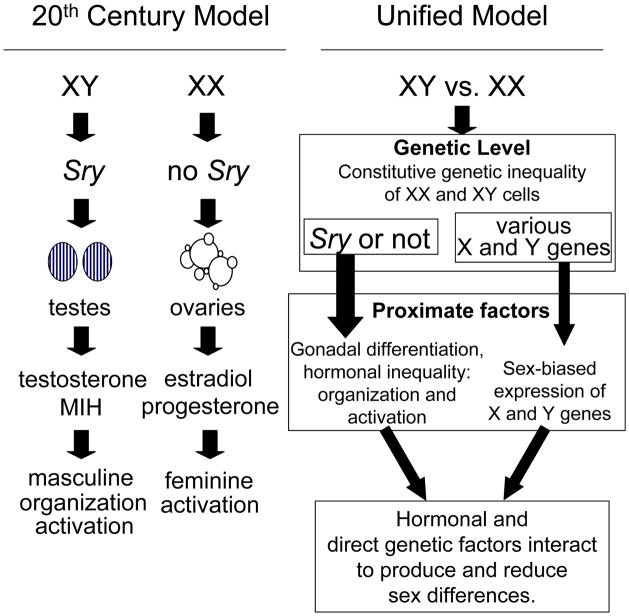Figure 1.
Contrast between the predominant 20th Century model to explain sex differences in the phenotype of tissues, with a revised model. In the 20th Century model, the sexual differentiation of the gonads is ascribed to the male-specific effect of the Y-linked gene Sry. Once the gonads have differentiated, they secrete different sex steroid hormones. Based on the organizational -activational framework of Phoenix et al., (1959), the testicular hormones testosterone and Müllerian inhibiting hormone (MIH) acts on diverse tissues (e.g., genital tracts and brain) in the fetal/neonatal male to cause masculine patterns of development resulting in permanently sexually differentiated substrates. Later in life, ovarian and testicular hormones act differentially on those substrates to create further sex differences in phenotype. In contrast, the unified model recognizes that Sry and other (to be identified) X and Y genes occupy the same primary logical level because they are all unequally encoded by the sex chromosomes in males and females. Some X and X genes act in a sex-specific manner, on the gonads and other tissues, to cause sex differences in XX and XY cells. Sry plays a dominant role by setting up the lifelong sex difference in secretion of gonadal hormones, which have organizational and activational effects on the brain and other tissues. Because of the independent sex differences in sex chromosome genes, and in hormonal secretions, the various sex-specific factors interact in one of several ways. Their effects are synergistic (as for example when Y factors and testicular testosterone both push the male’s tissues to function differently than in females), or they counteract each other to reduce sex differences (for example when the female-specific process of X-inactivation shuts down one X chromosome in each female cell to counteract the female bias in X gene expression that would otherwise occur). With minor modification the schema shown here can apply equally to birds or other groups that have a constitutive sexual imbalance of sex chromosome genes, by substituting species-appropriate sex determining gene(s) for Sry.

